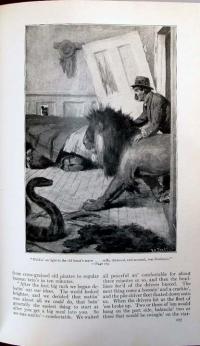

The American artist Arthur Burdett Frost produced illustrations for nearly 100 books from 1876 until his death in 1928. He worked alongside Howard Pyle and Frederic Remington for the leading publishers of the day, including Harper & Brothers and Scribner’s. While he made his living primarily as a commercial artist, Frost studied painting with Thomas Eakins and William Merritt Chase at the Pennsylvania Academy of the Fine Art and lived for awhile in Paris, hoping for success as a “serious painter” [his words]. Although he never gave up painting entirely, in 1914 Frost and his family returned to the United States and he resumed work as an illustrator.
In 1917, Frost wrote “… am going to take up caricaturing with a view of getting into the syndicate job. If it all goes at all it means better pay that I could get in any other way. Caricature is with me a separate thing from my life. I can draw absurd things that amuse others but do not affect me. I am wretchedly unhappy and always will be but I can make “comic” pictures just as I always did.”
One of the commissions he recieved that year was to illustrate a short story by the mystery writer Hugh Wiley. Wiley is best known today for his character James Lee Wong, who was the focus of a series of stories in Collier’s magazine and then, in movies as played by Boris Karloff. Wiley’s short story “On the Altar of Hunger,” illustrated by Frost, appeared in the August issue of Scribner’s Magazine, and later, unillustrated, in 50 Best American Short Stories 1915-1939 edited by Edward O’Brien (New York: Literary Guild of America [1939]) Firestone Library (F) 3588.684.2
Page 177 of Scribner’s shows the published version of Frost’s ink wash drawing, now in the collection of graphic arts. The choice of blue is interesting, since in the 20th century, magazine illustrators made corrections in blue, which could then be screened out of the published image. Here those elements are included as an added tone.